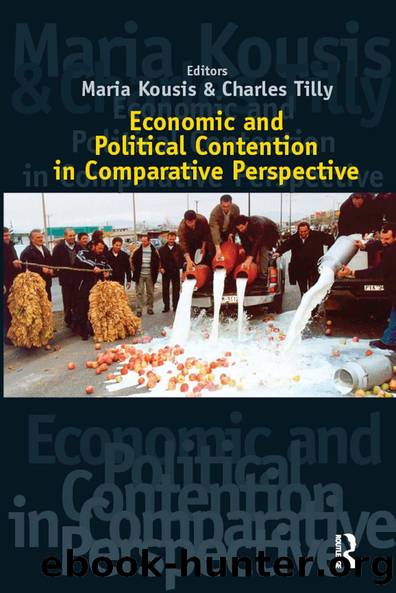Economic and Political Contention in Comparative Perspective by Maria Kousis Charles Tilly

Author:Maria Kousis, Charles Tilly [Maria Kousis, Charles Tilly]
Language: eng
Format: epub
Tags: Social Science, Sociology, General
ISBN: 9781317260844
Google: -TEeCwAAQBAJ
Publisher: Routledge
Published: 2015-12-03T02:51:23+00:00
Table 7.3a. Closing of all chapters of the Acquis across applicant countries, first wave
Table 7.3b. Closing of all chapters of the Acquis across applicant countries, second wave
Table 7.4. Duration of chapter negotiations, Czech Republic
Table 7.5. Duration of chapter negotiations, Slovakia
Table 7.6. Duration of chapter negotiations, Poland
While some chapters were opened at different times across groups of countries but closed at the same time, as above, differences in others reflected natural differences in applicant countries; the chapter on fisheries, for example, was a significant concern in some countries but not in others. Most applicant countries faced challenges in the field of domestic media, which previously had been controlled by communist regimes, but the chapter on culture and audiovisual policy was closed after sixteen months by the Czech Republic and Slovenia but only after thirty-three months in Hungary owing to controversy surrounding its Act on Radio and Television Broadcasting. Other possible explanations for the remaining variations might include differences in perceived negotiating strength among applicant countries, so that some countries may have simply accepted the European Unionâs proposal concerning the free movement of capital and negotiated for six months (Estonia, Latvia, Lithuania, and Slovakia), while others negotiated hard for separate deals to reflect their own concerns and negotiated for thirty months (Poland).
Patterns of transition periods. In addition to similarities in patterns of openings and closings, this chapter considers patterns of transition periods at the conclusion of accession negotiations. If the European Union were conducting its negotiations on the principle of differentiation, one would expect there to be significant differences in the patterns of transition periods that reflect differences among the applicant countries. As of June 2003, the number of transition periods for countries accepted to join the European Union ranged from nine in the Czech Republic and Estonia to fourteen in Poland (in tables 7.2a and 7.2b transition periods agreed upon are indicated by asterisks in particular chapters). Given differences across applicant countries, it is striking that the difference between the most and fewest transition periods is only five chapters, and the majority of transition periods were negotiated in 2001 for a similar group of chapters: free movement of capital, of persons, and of services; energy and the environment; and taxation.
Similarities in the number and nature of transition periods suggest common pressures for institutional and policy changes currently beyond the reach of applicant countries. In contrast to previous enlargements when new members such as Spain and the United Kingdom were granted long transition periods to adjust to EU policies, the European Union sought to minimize agreements for transition periods in the current wave of enlargement, creating pressures for rapid change among applicant countries prior to membership. Transition periods in some cases (such as free movement of persons) reflect the European Unionâs concerns about the consequences of enlargement (in this case, fears of migration). In other cases, transition periods reflect concerns of applicant countries (such as free movement of capital, which pertains to the right of noncitizens to purchase land). In the areas
Download
This site does not store any files on its server. We only index and link to content provided by other sites. Please contact the content providers to delete copyright contents if any and email us, we'll remove relevant links or contents immediately.
Adding Value to Policy Analysis and Advice by Claudia Scott; Karen Baehler(460)
Sociological Perspectives of Health and Illness by Constantinos N. Phellas(449)
Race and American Political Development by unknow(447)
American Government and Politics Today by Steffen W. Schmidt Mack C. Shelley Barbara A. Bardes(435)
Human and Global Security : An Exploration of Terms by Peter Stoett(429)
Control Of Oil - Hardback by Kayal(409)
Entrepreneurship Education and Training: The Issue of Effectiveness by Colette Henry Frances Hill Claire Leitch(376)
Materializing the Middle Passage by Jane Webster;(365)
The Catholic Church and European State Formation, AD 1000-1500 by Jørgen Møller(359)
Advances in Child Development and Behavior, Volume 37 by Patricia J. Bauer(356)
The World According to China by Elizabeth C. Economy(347)
Left Is Not Woke by Susan Neiman(329)
Theories of Counseling and Psychotherapy: A Case Approach by Nancy L. Murdock(318)
Turkey's Relations with the West and the Turkic Republics: The Rise and Fall of the Turkish Model by Idris Bal(317)
Cross-Cultural Child Development for Social Workers by Lena Robinson(314)
Japan's Ainu Minority in Tokyo by Mark K. Watson(299)
Laboratory Life by Bruno Latour(296)
Beyond Service: State Workers, Public Policy, and the Prospects for Democratic Administration by Greg McElligott(287)
The Oxford Handbook of Museum Archaeology by Stevenson Alice;(278)
